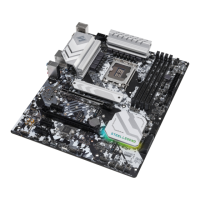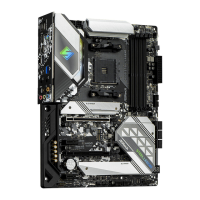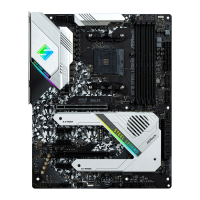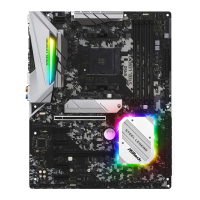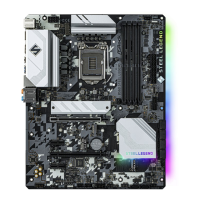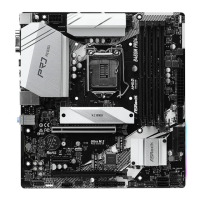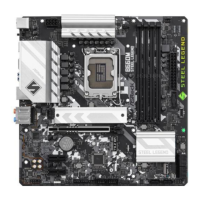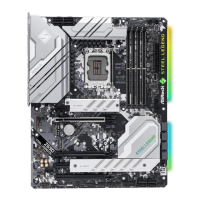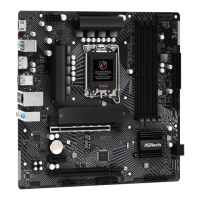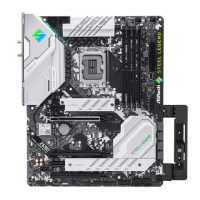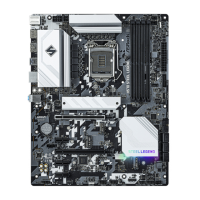
Do you have a question about the ASROCK H570 Steel Legend and is the answer not in the manual?
| Processor socket | LGA 1200 (Socket H5) |
|---|---|
| Processor manufacturer | Intel |
| Compatible processor series | Intel Celeron, Intel Core i3, Intel Core i5, Intel Core i7, Intel Core i9, Intel Pentium |
| Non-ECC | Yes |
| Memory channels | Dual-channel |
| Memory slots type | DIMM |
| Number of memory slots | 4 |
| Supported memory types | DDR4-SDRAM |
| Maximum internal memory | 128 GB |
| Supported memory clock speeds | 4666, 4800 MHz |
| Supported storage drive interfaces | M.2, SATA III |
| Parallel processing technology support | - |
| USB 2.0 connectors | 2 |
| Number of SATA II connectors | 0 |
| Number of SATA III connectors | 6 |
| USB 3.2 Gen 2 (3.1 Gen 2) connectors | 1 |
| DisplayPort version | 1.4 |
| USB 2.0 ports quantity | USB 2.0 ports have a data transmission speed of 480 Mbps, and are backwards compatible with USB 1.1 ports. You can connect all kinds of peripheral devices to them. |
| Wi-Fi | No |
| LAN controller | Dragon RTL8125BG |
| Ethernet interface type | 2.5 Gigabit Ethernet |
| Component for | PC |
| Motherboard chipset | Intel H570 |
| Audio output channels | 7.1 channels |
| Motherboard form factor | ATX |
| PCI Express x1 (Gen 3.x) slots | 3 |
| BIOS type | UEFI AMI |
| ACPI version | 6.0 |
| System Management BIOS (SMBIOS) version | 2.7 |
| Cables included | SATA |
| Harmonized System (HS) code | 84733020 |
| Depth | 244 mm |
|---|---|
| Width | 305 mm |
Lists all items included in the motherboard package for a complete setup.
Details the technical specifications of the ASRock H570 Steel Legend motherboard.
Visual guide identifying key components and connectors on the motherboard.
Explains the rear input/output ports and their specific functions.
Essential safety and handling guidelines before installing motherboard components.
Step-by-step instructions for correctly installing the CPU into the socket.
Guide on mounting the CPU cooler and fan for effective heat dissipation.
Instructions for installing DDR4 memory modules into the motherboard slots.
Information on PCI Express slots, their configurations, and compatibility.
Explains the function and configuration of motherboard jumpers for system settings.
Details the various internal headers and connectors on the motherboard for system integration.
Covers CrossFireX setup and driver installation for optimizing multiple graphics cards.
Guide for installing wireless and Bluetooth modules into M.2 slots.
Instructions for installing M.2 NVMe SSDs in the M2_1 slot.
Instructions for installing M.2 NVMe SSDs in the M2_2 slot.
Instructions for installing M.2 NVMe SSDs in the M2_3 slot.
Steps to install essential drivers and system utilities from the support CD.
Guide to ASRock's comprehensive system management software for monitoring and tuning.
Information on ASRock's platform for software updates, downloads, and app management.
Overview of the Nahimic audio enhancement software for improved sound performance.
Guide to customizing motherboard RGB lighting effects and patterns.
Explains the purpose and access methods for the UEFI BIOS setup utility.
Introduction to the simplified BIOS interface for quick system status checks.
Details the advanced BIOS interface, menu bar, and keyboard navigation keys.
Description of the main UEFI screen and managing favorite BIOS settings.
Configuration options for system overclocking, CPU, and DRAM performance tuning.
Access to detailed system configurations for CPU, Chipset, Storage, and other components.
Explanation of the utility tools available within the UEFI setup for system management.
How to monitor system temperatures, fan speeds, and voltages for performance and stability.
Settings for system security, supervisor/user passwords, and secure boot.
Configuration for boot device priority, startup options, and CSM settings.
Procedures for saving or discarding changes and exiting the UEFI setup utility.
